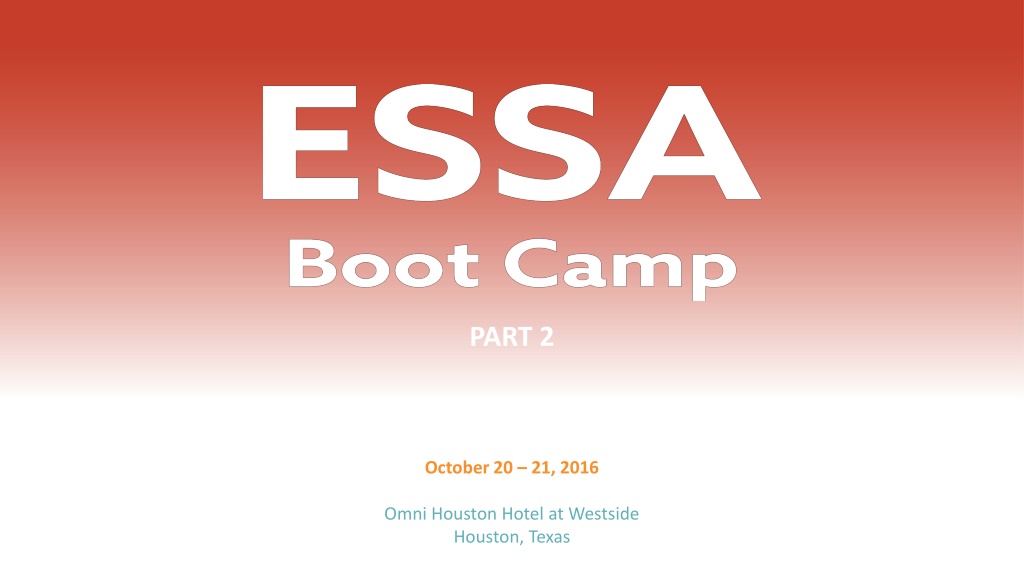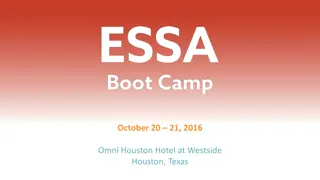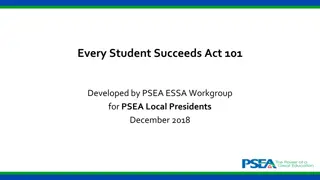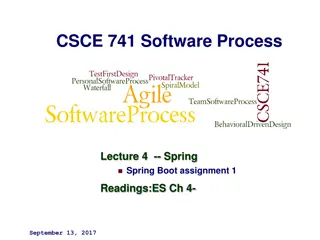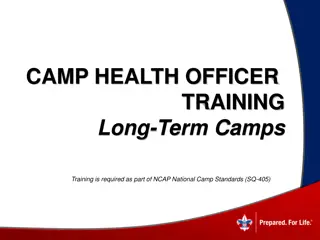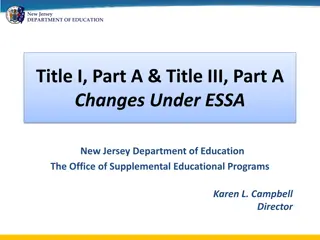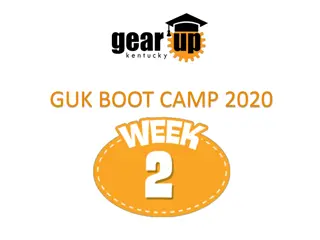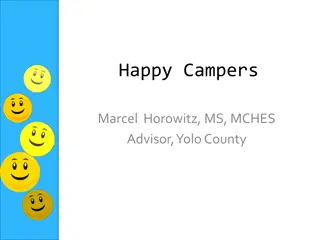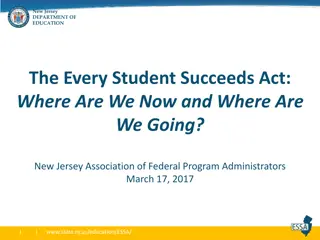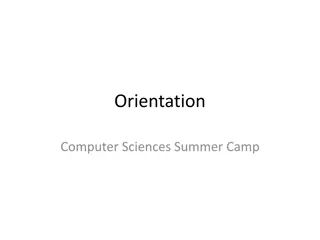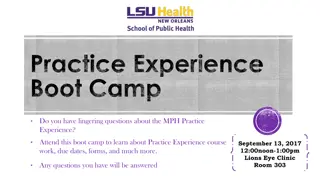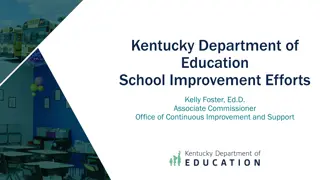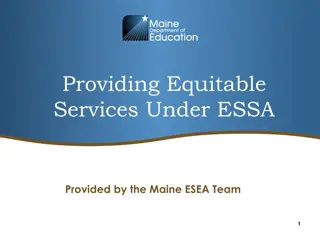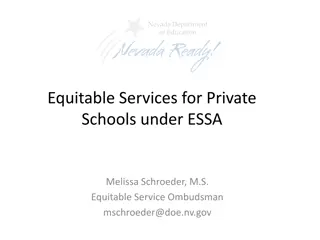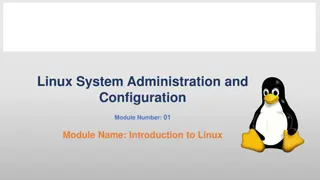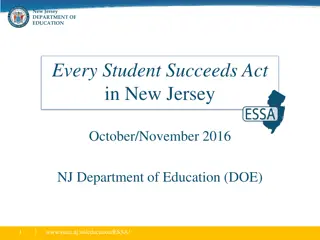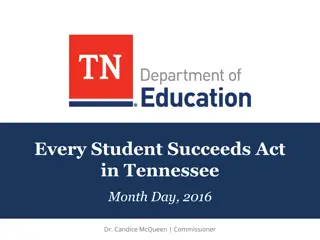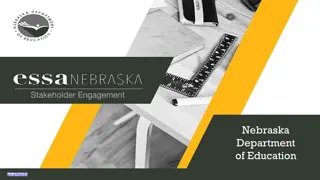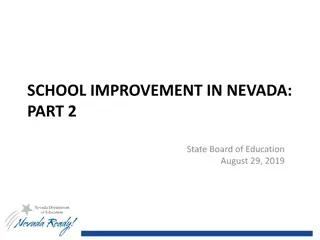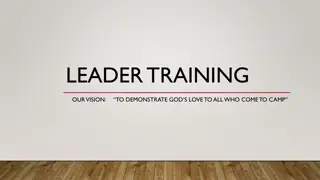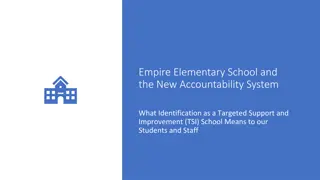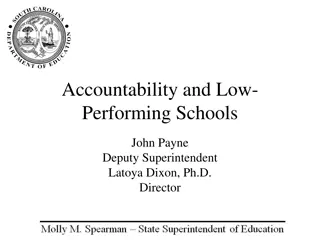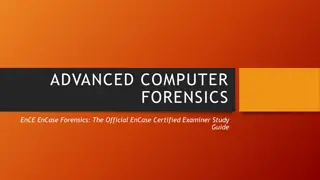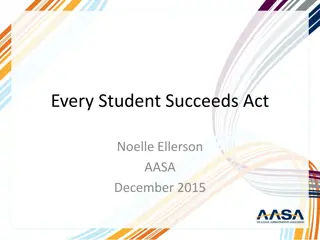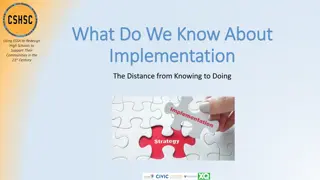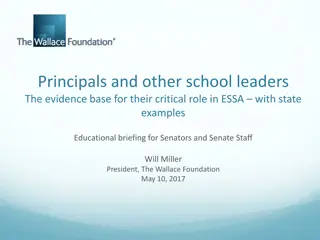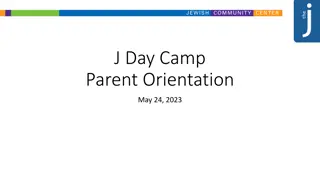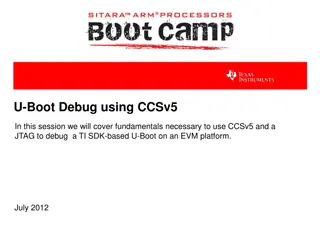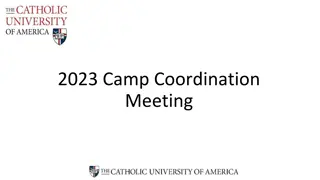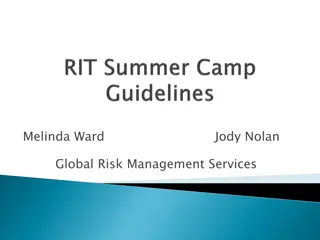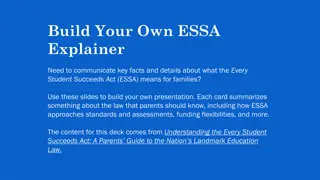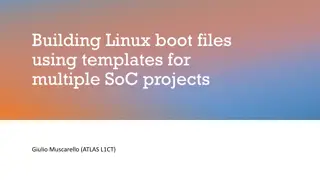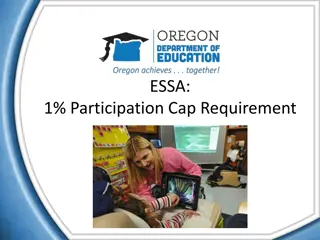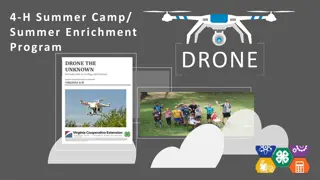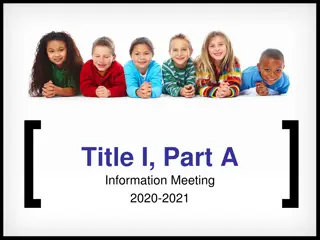ESSA Boot Camp: School Improvement and Next Steps
Dive into the ESSA Boot Camp discussions on school improvement strategies post-identification, moving beyond school ratings towards action-oriented support and resource allocation. Explore the importance of clear expectations and necessary resources for effective school improvement processes, focusing on developing literacy skills, refining discipline policies, and enhancing teacher training. Understand the critical shift from evaluating schools to implementing targeted interventions for sustainable progress.
Download Presentation

Please find below an Image/Link to download the presentation.
The content on the website is provided AS IS for your information and personal use only. It may not be sold, licensed, or shared on other websites without obtaining consent from the author. Download presentation by click this link. If you encounter any issues during the download, it is possible that the publisher has removed the file from their server.
E N D
Presentation Transcript
SUBTITLE PART 2 October 20 21, 2016 Omni Houston Hotel at Westside Houston, Texas ESSA Boot Camp | October 2016
IMPROVEMENT PLANNING Kati Haycock, The Education Trust ESSA Boot Camp | October 2016
What Comes Next? Mobilizing Change in Low Performing Schools and Schools that are Consistently Underperforming for Any Group ESSA Boot Camp | October 2016
So far in our conversations, weve focused primarily on how states could assign ratings to schools What are the expectations for performance on the things we measure? (Goals/Expectations) What should we measure? (Indicators) Ratings How do we identify schools for support and improvement? (Including schools that are consistently underperforming for 1+ groups of students) ESSA Boot Camp | October 2016
But if the ratings arent accompanied by a clear expectation of action expectation of action and the supports/resources needed to take that action they won t get us very far. ESSA Boot Camp | October 2016
Today, we move away from ratings, and shift to talking about the school improvement process school improvement process what happens after the school has been identified? or, ESSA Boot Camp | October 2016
Last nights performance put our minds squarely back Last night s performance put our minds squarely back on schools themselves: what the good ones on schools themselves: what the good ones DO the not the not- -so so- -good ones good ones DON T. DON T. DO and and ESSA Boot Camp | October 2016
And I know that most of you in this room would absolutely LOVE And I know that most of you in this room would absolutely LOVE to jump into the conversation of what to do to jump into the conversation of what to do about about that particular not that particular not- -so so- -good school. good school. What changes to instruction are needed to develop students literacy skills? What discipline policies could the school implement to replace zero tolerance ? What kind of professional development might raise teachers expectations? How could the school structure the school day to give teachers more time for collaboration? What role could an engaged group of parents and community-based organizations play? with, for, or with, for, or ESSA Boot Camp | October 2016
That, after all, is what drew most of you into That, after all, is what drew most of you into this room in the first place: this room in the first place: Your knowledge that too many schools just plain aren t getting kids where they need to go. Your understanding that many of them will need help of different sorts to improve. And your desire to think about what kinds of help might be most effective. ESSA Boot Camp | October 2016
Were not going to have that We re not going to have that conversation today. conversation today. That s the conversation that will take place at the community and school level. ESSA Boot Camp | October 2016
Our job is to build a strong foundation and create the right framework right framework for schools and districts to be able to make effective changes. strong foundation ESSA Boot Camp | October 2016
Because the decisions states make about: Because the decisions states make about: Who needs to come to the table; The content and timelines of the planning process; The resources available to implement the improvement plan; The role of districts and states when a school doesn t improve; Any protections the state should offer students in low-performing schools ESSA Boot Camp | October 2016
Past laws were far more prescriptive about school improvement. ESSA lays out a few things and leaves the rest of the decisions up to states and districts. ESSA Boot Camp | October 2016
Throughout todays conversation, youll want to keep two different kinds of schools in mind. Schools rated in the bottom 5% (and schools with low graduation rates), known as low-performing or comprehensive support and improvement schools; and, Schools that have consistent underperformance for one or more groups of students, known as targeted support and improvement schools. (Note: There is also a subset of targeted support and improvement schools called additional targeted support and improvement schools where the performance for any group of students falls below the cut-off for the bottom 5% of Title I schools.) ESSA Boot Camp | October 2016
States and districts have different responsibilities States and districts have different responsibilities in relation to different kinds of schools. in relation to different kinds of schools. While the basic process is almost the same for all schools flagged under state accountability systems, who is responsible for each stage varies. School type Identified by Plan submitted by Plan approved by Comprehensive (bottom 5%) state district state Targeted (consistently underperforming subgroup) Additional targeted (bottom 5% subgroup) state school district state school district ESSA Boot Camp | October 2016
ESSA School Improvement Timeline: Schools in Bottom 5% ( Comprehensive ) District submits improvement plan State approves plan State assesses school s progress against exit criteria New accountability system in place State IDs school School implements plan with district support, revising as needed Diagnosis Intensification Support, Assistance, and Monitoring Transition Planning Status Quo Now Year 3 Year 5 Year 0 Year 2 Year 4 Year 1 State IDs next cohort of Comprehensive Support and Improvement schools NOTE: This timeline is based on ESSA and our best guess about the final regulations. ESSA Boot Camp | October 2016
ESSA School Improvement Timeline: Targeted and Additional Targeted Support and Improvement (subgroup schools) If Targeted schools fail to improve within district- determined number of years, district has to require additional action. For Additional Targeted schools, the State determines number of years school has to meet exit criteria before being IDed for comprehensive support. . School submits improvement plan District/state assesses school s progress against exit criteria District approves plan New accountability system in place State IDs school School implements plan with district support, revising as needed Intensification/ Comprehensive Support Diagnosis Support, Monitoring, and Assistance Status Quo Transition Planning Now Year 0 Year 1 Year 2 Year 3 Year 4 Year 5 State IDs next cohort of Comprehensive Support and Improvement schools State IDs new cohort of Targeted schools annually NOTE: This timeline is based on ESSA and our best guess about the final regulations. ESSA Boot Camp | October 2016
Were going to focus today We re going to focus today least initially least initially on what happens on what happens during that planning year. during that planning year. at at But first, let s think about what a coherent school improvement process looks like. ESSA Boot Camp | October 2016
The Improvement Process The Improvement Process Plan implementation (with support/ resources as necessary) Improvement Planning School Ratings Needs Assessment Monitoring Plan Approval ESSA Boot Camp | October 2016
This is NOT what the school improvement planning This is NOT what the school improvement planning process has looked like in most places. process has looked like in most places. READY, FIRE, AIM! ESSA Boot Camp | October 2016
Ready, fire, aim! Ready, fire, aim! Schools were typically identified as needing improvement in August; Principals often had about a month to create a plan (or 2 or 3 plans) and usually when both teachers and parents weren t around; Because there was little time for a needs analysis, test scores themselves were often considered root causes, which is why improvement plans so often had dumb stuff like test prep; And schools were supposed to implement their plans immediately, even though budget decisions were already made and master schedules already set in concrete. ESSA Boot Camp | October 2016
Not surprisingly, in a lot of places most schools didn t actually get better even when they got pretty generous funding. 1/3 School Improvement Grant (SIG) Schools Got Better 2/3 School Improvement Grant (SIG) Schools Stayed Same or Got Worse ESSA Boot Camp | October 2016
There are a lot of possible reasons for that. There are a lot of possible reasons for that. But our job is to advocate for changes to the needs assessment and improvement planning process that will raise chances for success. ESSA Boot Camp | October 2016
What might some of those What might some of those changes be? changes be? ESSA Boot Camp | October 2016
Changes to the School Improvement Planning Process Changes to the School Improvement Planning Process 1. Set an appropriate timeline for the needs assessment/improvement planning process Set criteria for what it means for a school to improve. 2. Ensure that parents and the community are involved every step of the way. 3. Ensure that the improvement process begins with a meaningful needs assessment. Decide what actions to take if a school does not improve in a reasonable timeframe. 4. Ensure that improvement plans lay out evidence-based strategies that address the challenges identified in the needs assessment Provide additional protections to students in low-performing schools. 5. Use school improvement funding as a strategic lever. ESSA Boot Camp | October 2016
1. Set an appropriate timeline for the needs 1. Set an appropriate timeline for the needs assessment and planning process. assessment and planning process. 34 ESSA Boot Camp | October 2016
Hitting the right balance in the improvement Hitting the right balance in the improvement process timeline is tricky. process timeline is tricky. Too short a timeline, and the process will be too rushed to get to real root causes and engage all relevant stakeholders. Too long a timeline, and action is unnecessarily delayed. If schools actually take a full year to write their plan, that really means two years before that plan is implemented because budget and personnel decisions are made in the Spring. That s two years before students experience improvements in their education. ESSA Boot Camp | October 2016
The best timeline may vary from state to state, depending upon budgeting and scheduling practices, but you won t want to leave this to chance. ESSA Boot Camp | October 2016
Recommendation #1: States Should Adopt Appropriate Planning Timelines If schools are going to be ready to implement changes in the Fall, states should adopt a school improvement timeline that requires needs assessment, planning, and plan approval including ongoing community engagement to occur early enough that the plan can inform key decisions that need to made for the next fall. ESSA Boot Camp | October 2016
Suggested Timeline: The Planning Year What decisions will schools & districts have to make to implement their improvement plan at the start of the next school year? Hiring teachers/instructional support Assigning teachers to classes Assigning students to classes Structuring the school day Purchasing resources Offering school choice Bring together school/ community stakeholders Share needs assessment with broader community Share plan with broader community Improvement planning begins Needs assessment begins School/district submits plan District/state approves plan State IDs school District support Review Period* Decisions for Next School Year Needs Assessment Improvement Planning May March April June January February November August October December September Note: For schools with different academic calendars, this timeline will shift accordingly. * Districts may require a shorter review period than states. ESSA Boot Camp | October 2016
2. Ensure that parents and the community are involved at every step of the way. 34 ESSA Boot Camp | October 2016
In most school improvement planning processes, parents and community organizations are either left out or engaged only on a token basis. ESSA Boot Camp | October 2016
Thats unfortunate, because it misses a hugely important source of insight, and leaves out potentially powerful partners. ESSA Boot Camp | October 2016
Certainly, parents dont need (or want) to be involved in every detail for example, which instructional materials or professional development programs might be most effective in raising the caliber of instruction. But their partnership in developing the overall plan But their partnership in developing the overall plan is critical. is critical. ESSA Boot Camp | October 2016
ESSA requires that school improvement plans be developed in consultation/partnership with stakeholders (including principals and other school leaders, teachers, and parents). ESSA Boot Camp | October 2016
Recommendation #2: States should ensure that parent/community participation in improvement planning is substantial and meaningful. Require that all school improvement plans document the involvement of parents and community organizations in the school improvement planning process up front, during the process, and at the conclusion. In the case of plans from targeted support and improvement schools, require that parents of students from the affected group (for which school is identified for consistent underperformance) be included. Provide a rubric showing what good, acceptable, and unacceptable forms of involvement look like. (Maybe Coalition organizations could help?) State should reject any plans with unacceptable community involvement. ESSA Boot Camp | October 2016
3. Ensure that the improvement process begins with a meaningful needs assessment ESSA Boot Camp | October 2016
What do we mean by needs assessment and why does it matter? ESSA Boot Camp | October 2016
A needs assessment is a systematic process for understanding the school and district-based causes of underperformance. It is more than just pieces of information it s a process/set of questions used to look at that information. ESSA Boot Camp | October 2016
In many states, schools are left on their own to conduct a needs assessment, or are given tools that only ask them to look at achievement data and student demographics. ESSA Boot Camp | October 2016
Without guidance, school and district leaders often bypass the needs assessment step and jump to the happier task of brainstorming solutions. So, the solutions don t necessarily address the challenges the school faces. ESSA Boot Camp | October 2016
Even when tools are available, they often don t ask the tough questions. ESSA Boot Camp | October 2016
What kinds of questions should a needs What kinds of questions should a needs assessment ask? assessment ask? ESSA Boot Camp | October 2016
Research highlights educational factors that matter for Research highlights educational factors that matter for student learning, such as: student learning, such as: Aligned curriculum Effective instruction Strong leadership Supports for students and teachers A safe and positive climate Family and community engagement ESSA Boot Camp | October 2016
Certainly, a good needs assessment will address these things. But each of these domains can be approached from a general perspective, and from an equity perspective. ESSA Boot Camp | October 2016
Whats the difference? General Questions Equity Questions What are the professional qualifications of teachers in the school? Do all students have equitable access to strong teachers? Teaching Quality What percent of students take advanced coursework (AP, IB, dual enrollment)? How do rates of participation/success in advanced courses differ for students with disabilities? Effective Instruction What percent of students are chronically absent? How do the rates of chronic absenteeism differ by student group? Student Support Services ESSA Boot Camp | October 2016
In comprehensive schools, that are low-performing overall, more of the focus should be on general questions. In targeted schools, which are underperforming for one or more groups of students, every question should be equity-focused. ESSA Boot Camp | October 2016
ESSA also requires an analysis of whether comprehensive schools are getting their fair share of critical educational resources dollars, teachers and the like. ESSA Boot Camp | October 2016
What kinds of data should states make What kinds of data should states make sure schools have access to? sure schools have access to? ESSA Boot Camp | October 2016
States already have to make available state and local report cards, which contain valuable information but it s not enough not enough. ESSA Boot Camp | October 2016
